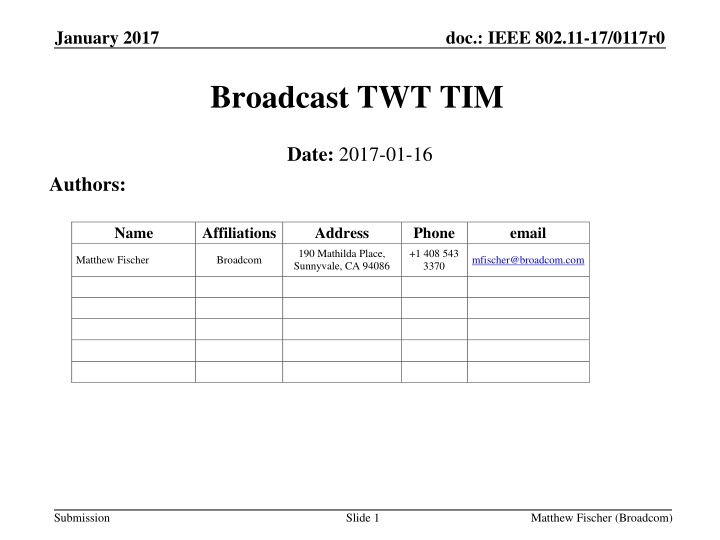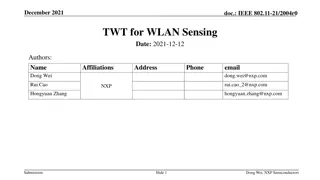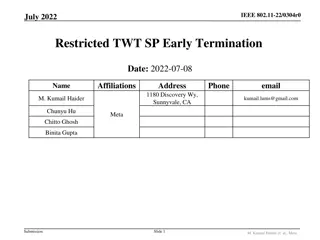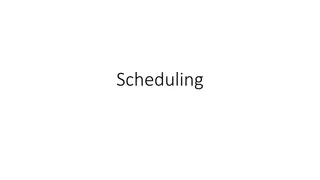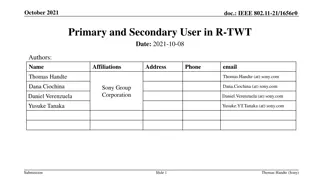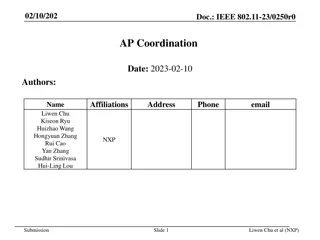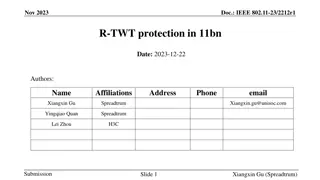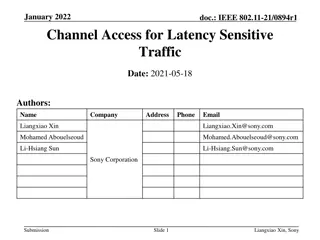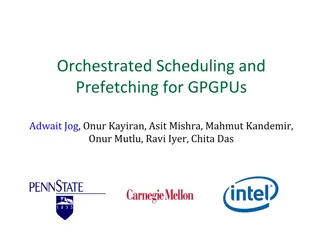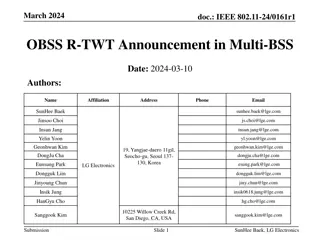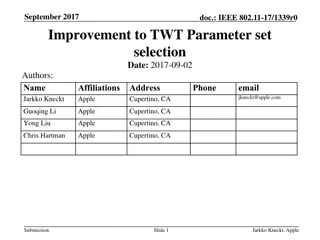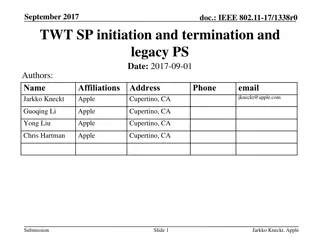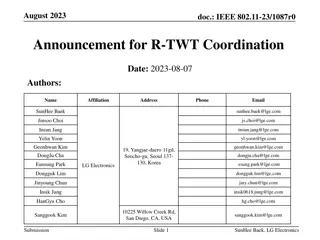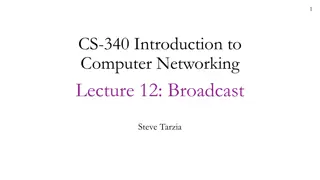Enhancing 802.11 Scheduling with Broadcast TWT and TIM Mechanisms
The January 2017 document IEEE 802.11-17/0117r0 discusses the implementation of coordinated multi-user downlink and triggered multi-user uplink in 802.11 systems to improve scheduling and reduce collisions. It proposes aligning power saving wake times using Target Wake Time (TWT) for better efficiency. The document also addresses issues with Broadcast TWT and Trigger Frame timing coordination for non-AP STAs. Suggestions include associating a TIM with each Broadcast TWT for improved wakeup decisions by participating STAs.
Uploaded on Sep 06, 2024 | 5 Views
Download Presentation

Please find below an Image/Link to download the presentation.
The content on the website is provided AS IS for your information and personal use only. It may not be sold, licensed, or shared on other websites without obtaining consent from the author.If you encounter any issues during the download, it is possible that the publisher has removed the file from their server.
You are allowed to download the files provided on this website for personal or commercial use, subject to the condition that they are used lawfully. All files are the property of their respective owners.
The content on the website is provided AS IS for your information and personal use only. It may not be sold, licensed, or shared on other websites without obtaining consent from the author.
E N D
Presentation Transcript
January 2017 doc.: IEEE 802.11-17/0117r0 Broadcast TWT TIM Date: 2017-01-16 Authors: Name Affiliations Address Phone email 190 Mathilda Place, Sunnyvale, CA 94086 +1 408 543 3370 Matthew Fischer Broadcom mfischer@broadcom.com Submission Slide 1 Matthew Fischer (Broadcom)
January 2017 doc.: IEEE 802.11-17/0117r0 Abstract Coordinated MU DL and Triggered MU UL are the first step toward a more scheduled behavior in 802.11 The inclusion of such scheduling is intended to make 802.11 systems more well behaved E.g. fewer collisions, less MAC overhead Alignment between MU DL, MU UL and PS wake times is the next step forward for power savings TWT should be used for aligning PS STA wake times with MU DL and MU UL operations TIM Use for BTWT is defined, but has problems Submission Slide 2 Matthew Fischer (Broadcom)
January 2017 doc.: IEEE 802.11-17/0117r0 CID 8108 Broadcast TWT - a non-AP STA that is participating in Broadcast TWT will wake for TWT SPs and then check trigger frames to see if the STA is identified in a trigger. If there is more than one trigger for an SP, the STA will wake for multiple triggers and by the end of the SP, it is possible that the STA has not been identified and therefore, has wasted power checking each trigger. It would be more efficient for power consumption if the STA had a clue as to whether any trigger in the SP was going to identify it. Add a TIM of some sort to be associated with each Broadcast TWT so that a participating STA can wake at the beacon and read the TWT-TIM to see if it should be waking for any of the triggers associated with this broadcast TWT within this beacon interval. The TIM could also be included at the start of each TWT SP, say, within a beacon- like frame, e.g. measurement pilot frame or something else. Submission Slide 3 Matthew Fischer (Broadcom)
January 2017 doc.: IEEE 802.11-17/0117r0 TIM for Trigger Frame is Not Well- Coordinated Trigger frames today: Trigger frame timing is indicated in Beacon with Broadcast TWT Provides timing of major trigger phase sequences Cascade Indication used to indicate the presence of additional minor triggers within a sequence A STA waking to find Broadcast trigger frame indication(s) in the Beacon cannot know if the triggers for any particular time will include this STA Opportunistic Power Save defines use of TIM at start of BTWT SP PS STA must wake for start of every BTWT SP to see if it is named With each BTWT, PS STA is waking unnecessarily as it is unlikely to be named as a triggered/served STA in all BTWT Submission Slide 4 Matthew Fischer (Broadcom)
January 2017 doc.: IEEE 802.11-17/0117r0 27.14.3.1 AP operation for opportunistic power save Opportunistic power save mechanism has the objective for an AP to split a beacon interval into several periodic broadcast TWT SPs and to provide, at the beginning of each SP, the scheduling information to all non-AP STAs. Based on this information, the non-AP STAs may opportunistically go to doze state until the next TWT SP. This is still not as efficient as desired and has some technical problems as described next: Submission Slide 5 Matthew Fischer (Broadcom)
January 2017 doc.: IEEE 802.11-17/0117r0 Problem 1 When exactly, does the TIM appear? D1.0 says at the beginning of each SP BTWT periodicity can be < BI So, which Trigger is the TWT SP start? First Trigger after Beacon? Submission Slide 6 Matthew Fischer (Broadcom)
January 2017 doc.: IEEE 802.11-17/0117r0 Problem 2 BTWT ID values 0 = all STA Non-zero = per STA signup Possible need for more than one all STA BTWT Submission Slide 7 Matthew Fischer (Broadcom)
January 2017 doc.: IEEE 802.11-17/0117r0 Problem 3 STA wake times: Typically, a STA already wakes at TBTT for Beacon reception Current language suggests that STA must: Wake for TBTT to check BTWT IE values in Beacon Then schedule additional wake times for all beginning BTWT SP to find TIM for each one The more the BTWT indicated, the more the wake requirement Would be nice to find all BTWT information at this one wake time STA can then schedule future wake times Submission Slide 8 Matthew Fischer (Broadcom)
January 2017 doc.: IEEE 802.11-17/0117r0 Problem 4 For any HE non-AP STA for which their associated AP set their corresponding bit in the traffic indication virtual bitmap field of the TIM element to 0, the AP shall neither send unicast or multicast frames to those STAs, nor trigger those STAs for UL MU transmissions during the TWT SP and, unless otherwise specified, until the next TWT SP. Difficult to enforce the multicast provision, because multicast group membership determination is above L2 Submission Slide 9 Matthew Fischer (Broadcom)
January 2017 doc.: IEEE 802.11-17/0117r0 Problem 5 How long is the TIM indication valid? There is a series of Triggers for each BTWT When does a STA need to check for a new TIM? i.e. when is the next start of this SP? Submission Slide 10 Matthew Fischer (Broadcom)
January 2017 doc.: IEEE 802.11-17/0117r0 Proposed Change Add STA bitmap to Broadcast TWT To allow PS STA to efficiently wake and sleep Submission Slide 11 Matthew Fischer (Broadcom)
January 2017 doc.: IEEE 802.11-17/0117r0 Additional Information for PS STA For improved PS operation Add STA list to Broadcast TWT indication Add list of STA that might be addressed by a trigger in the Broadcast TWT indication E.g. a bitmap, reuse the TIM format Add an indication that the list is present Add a bit to the TWT control field TWT Bitmap Present A STA not listed in the bitmap is guaranteed to not be triggered And therefore may choose to doze during that trigger period A STA listed in the bitmap might be triggered And therefore should be awake during that trigger period Submission Slide 12 Matthew Fischer (Broadcom)
January 2017 doc.: IEEE 802.11-17/0117r0 Modified TWT Information Element Elemen t ID Lengt h Control Reques t Type Targe t Wake Time TWT Grou p Assig nment Nominal Minimu m Wake Duratio n TWT Wake Interval Mantiss a Broadc ast TWT ID TWT Chann el NDP Paging (optional) TWT TIM Octets: 1 1 1 2 8 or 0 9 or 3 or 0 1 2 0 or 1 1 0 or 4 0 or variable TWT TIM Length TWT TIM Bitmap Control Partial Virtual TWT TIM Bitmap Octets: 1 1 variable TWT TIM optionally added to TWT IE TWT TIM length indicates length of TWT TIM Bitmap Control plus Partial Virtual TWT Bitmap TWT TIM is a subset of TIM IE Submission Slide 13 Matthew Fischer (Broadcom)
January 2017 doc.: IEEE 802.11-17/0117r0 TWT TIM Present Indication B0 B1 B2 B3 B4 B5 B7 NDP Paging Indicator Responder PM Mode Broadcast Wake TBTT Negotiation TWT TIM Present Reserved Bits: 1 1 1 1 1 3 TWT IE Control Field is modified to include a TWT TIM Present bit If TWT TIM Present = 1, TWT TIM included in the TWT IE Length, Bitmap Control, Partial Virtual Bitmap If TWT TIM Present = 0, no TWT TIM present in the TWT IE Submission Slide 14 Matthew Fischer (Broadcom)
January 2017 doc.: IEEE 802.11-17/0117r0 TWT TIM Fields TWT TIM Length Length of the TWT TIM Bitmap Control and Partial Virtual TWT TIM Bitmap fields TWT TIM Bitmap Control Similar interpretation as TIM IE Bitmap Control field Bit 0 = Identification of Broadcast TWT SP When bit 0 = 1, the associated TWT SP is broadcast i.e. the TWT SP is for all associated STAs Bits 1 through 7 are the same as TIM Bitmap Control, defining the bitmap offset Partial Virtual TWT TIM Bitmap Same definition as TIM IE Partial Virtual Bitmap Submission Slide 15 Matthew Fischer (Broadcom)
January 2017 doc.: IEEE 802.11-17/0117r0 Straw Poll 1 Do you support a modification that optionally allows a TWT TIM field as defined in slides 13, 14, 15 to be included as part of the TWT IE? Yes No Abstain Submission Slide 16 Matthew Fischer (Broadcom)
January 2017 doc.: IEEE 802.11-17/0117r0 References [1] 802.11-2016.pdf [2] Draft P802.11ax_D1.0.pdf Submission Slide 17 Matthew Fischer (Broadcom)
